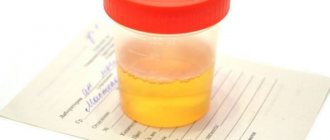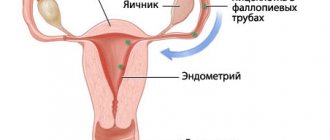Urine is one of the main biological fluids. Its analysis makes it possible to identify various pathologies in the human body or to assume that they are absent. Its composition can be influenced not only by health status, but also by the foods consumed.
Sometimes, when receiving test results, you can see a note that oxalate salts were found in the urine, and this factor is worth paying attention to.
This phenomenon is popularly known as “sand in the kidneys.”
When you see that such salts are found in your biological fluid, you should not immediately panic - you should first figure out what could have triggered the phenomenon and how to deal with it.
General information
Oxalates are salts or esters of oxalic acid. They are formed when it combines with inorganic elements: calcium, sodium, potassium, iron, magnesium. The metabolism of oxalic acid in the body occurs mainly in the intestines and kidneys. With a normal diet, up to 1 g of oxalate is supplied with food, the main part of which is excreted, and only 10% is absorbed unchanged into the blood. An important role in this process is played by individual representatives of the intestinal microflora - Oxalobacter formigenes. This microorganism regulates the level of oxalic acid, utilizing it in the process of its life.
But in addition to external intake, there is endogenous synthesis of oxalate, when it is formed by the metabolism of ascorbic or glyoxalic acids. Such products come at a rate of 1 mg per hour, occupying the main share in the exchange (70%). All oxalic acid is excreted in the urine, mainly binding to sodium and potassium. And when combined with calcium, it forms a practically insoluble salt, existing in the form of mono- or dihydrate. Calcium oxalate crystals are detected in many cases, including during pregnancy. Unlike other salts (urates or phosphates), they fall out with any reaction (pH) of urine.
Oxalates come from food or are synthesized in the body from other acids and are subsequently excreted by the kidneys.
Prevention measures
The main way to correct the condition of pregnant women who have increased the usually moderate level of oxalate in the urine is a diet that includes:
- lean boiled meat;
- porridge;
- dairy products;
- wholemeal bread.
Proper nutrition, which reduces the amount of calcium salts, as well as an optimal drinking regimen, will eliminate the likelihood of developing problems with the urinary system in the future.
The presence of oxalates in the urine may simply mean that the expectant mother is not eating properly and taking too many vitamins, however, the same condition often demonstrates the presence of problems with the genitourinary system (and sometimes also the gastrointestinal tract) in the woman’s body. To exclude the possibility of developing diseases, it is recommended to undergo examination and begin timely treatment. It is important to remember that oxalates are a potential danger to mother and baby.
Promotion
Urinary oxalate excretion beyond optimal values is always noticeable in the study results. If the daily level of oxalic acid salts exceeds 40 mg, then this situation is called hyperoxaluria. A high content of crystals should cause some concern for the woman and the doctor, because it can be associated with certain pathological processes. Some of them, one way or another, are associated with pregnancy, while others proceed in parallel. The first most often include:
- Enriching the diet with foods containing oxalates.
- Drinking small amounts of liquid.
- Taking vitamin complexes with ascorbic acid.
It would seem that these reasons are too banal, but a pregnant woman should pay attention to them. Firstly, oxalates can appear when their dietary intake increases (tomatoes, spinach, sorrel, rhubarb, legumes, nuts, berries, chocolate). And while pregnant, dietary preferences often change. Secondly, possible swelling in the second or third trimester may prompt a woman to limit her drinking regimen. In this case, the urine will naturally become more concentrated, and the salts will precipitate faster. Thirdly, wanting to saturate the body with useful substances, a pregnant woman may get carried away with taking vitamin preparations containing ascorbic acid. This will lead to an increase in endogenous oxalate synthesis, and, as a result, an increase in its urinary level.
Salts in the urine often appear due to changes in food habits, which is typical for pregnant women.
On the other hand, hyperoxaluria often indicates more serious changes in the body. They concern all systems involved in the metabolism of oxalic acid. Therefore, calcium oxalate crystals in urine may appear due to the following conditions:
- Renal pathology (urolithiasis, pyelonephritis).
- Diseases of the digestive system (calculous cholecystitis, chronic pancreatitis, ulcerative colitis, dysbacteriosis).
- Metabolic and endocrine disorders (diabetes mellitus).
- Hereditary diseases (primary hyperoxaluria).
- Intoxication with chemical compounds (ethylene glycol).
Inflammatory kidney diseases may first appear during pregnancy, as a consequence of the adverse effects of an enlarged uterus and hormonal conditions. A disturbance in urodynamics occurs and the preconditions are created for the development of infectious agents, which ultimately ends in pyelonephritis. And in addition to renal pathology, pregnant women also have a risk of carbohydrate metabolism disorders (decompensation of diabetes mellitus).
Kinds
The detection of oxalates during pregnancy often indicates pathological processes occurring in a woman’s body that affect the urinary system. The condition is dangerous because it practically does not manifest itself symptomatically, therefore it is detected only on the basis of a urine test and the results of instrumental examinations (ultrasound).
Several types of oxalates are commonly found in urine, each formed from salts of different types of substances. The most common are calcium oxalates, but concretions of crystallized potassium, ammonium and sodium salts combined with oxalic acid are also released. The formation of such stones is influenced by various factors - from improper diet to an excess of vitamins taken.
Recommended topic:
Medicines and drugs for sand in the kidneys
Symptoms
Since oxalates in urine during pregnancy are only a separate laboratory indicator, it is necessary to understand whether they have any clinical manifestations. Isolated hyperoxaluria is asymptomatic for a long time. But the salt crystals gradually grow, turning into real stones. This is when signs of oxalate nephropathy (urolithiasis) appear:
- Intense pain in the lower back and groin (renal colic).
- Dysuric disorders: difficulty urinating, frequent urge.
- Blood in the urine.
If salt crystals are detected in combination with leukocytes and bacteria, then such laboratory signs indicate pyelonephritis. In this case, the pain becomes aching, and other manifestations are noticeable:
- Urine becomes cloudy.
- Body temperature rises.
- Tapping along the costal arch from behind is painful (Pasternatsky's symptom).
When oxalate salts are detected against the background of diseases of a different origin, the clinical picture will have corresponding features. For example, in case of digestive disorders, diarrhea, flatulence, and abdominal pain are detected; Diabetes mellitus is accompanied by thirst, dry mouth, and an increase in the amount of urine produced.
Oxalates in the urine are a laboratory sign that can be combined with various clinical symptoms.
Norm, deviation and its manifestation
The normal level of oxalate in the urine of a pregnant woman is 20-40 mg, which results in 1-2 pluses. At this concentration, a single crystal of calcium salts (doctors also call it urate), even if formed, will be removed from the body without problems. An increase in the volume of oxalate substances will already cause problems - excess salts concentrate in the soft tissues, increase in size, harden and turn into a calculus, which may mean the onset of urolithiasis.
There are no specific symptoms indicating that large quantities of oxalates are formed in the body of the expectant mother. Doctors recommend not to ignore the following signs:
- problem with frequent and excessive urination;
- manifestations of general muscle weakness;
- increased and rapid fatigue with sleep disturbances;
- sharp cutting pains occurring in the abdominal area;
- renal colic;
- detection of bloody inclusions in the urine.
If you experience such symptoms, you should immediately consult a doctor to undergo diagnostic tests and determine the degree of danger of the condition for the mother and child.
Treatment
When salts in the urinary sediment increase, certain therapeutic measures are required aimed at eliminating the pathological process and preventing undesirable consequences for the body. First of all, the doctor prescribes a diet that helps eliminate oxalates. It should include the following products:
- Black bread.
- Porridge (oatmeal, buckwheat, wheat).
- Milk, kefir, yogurt.
- Eggs.
- Sea kale.
- Dried apricots, prunes.
- Lemon with honey.
Cereal products (bread, cereals) are a source of B vitamins, in particular pyridoxine, the deficiency of which can lead to the accumulation of oxalate. Dairy foods contain calcium, which binds excess oxalic acid in the intestines, and some fruits contain citrate, which helps dissolve the crystals. In addition, you must definitely drink a sufficient amount of liquid - preferably in the form of fruit juices, compotes, weak green tea.
If there are signs of inflammation in the kidneys, then more intensive treatment will be required, which may include herbal remedies (Canephron) or antibiotics. Diabetes mellitus must be compensated for by hypoglycemic agents, and diseases of the gastrointestinal tract often require other medications:
- Enzymes (Mezim).
- Antispasmodics (No-spa).
- Probiotics (Linex).
- Defoamers (Espumizan).
But in any case, use only those medications that are safe during pregnancy. They are prescribed by a doctor, and self-medication is associated with an unjustified risk for the woman and her unborn child.
The appearance of oxalates in the urine during pregnancy is a fairly common situation. In most cases, it occurs against the background of changes in dietary and drinking regime. But there are other situations associated with pathology of the kidneys, intestines, and metabolism. Then the woman needs to undergo full treatment under the guidance of a doctor.
Pregnancy at risk
In small amounts, oxalates in the urine during pregnancy are not an alarming sign, especially since after the first analysis that revealed these substances, you should undergo a repeat examination, which can confirm or refute the diagnosis. However, since the manifestation of urates is associated with a problem in the functioning of the kidneys, if the condition is neglected, it can harm the mother and her baby.
For a pregnant woman’s body, impaired kidney function means an increased load on the organ and a potential danger of intoxication of the body with substances that are no longer filtered by the urinary system. Also, problems with the kidneys are fraught with even greater accumulation of oxalates with their subsequent transformation into stones. And stones accumulated in the urinary system cause a number of problems. Every woman should know what this can mean:
- deformation of the renal nephrons and a decrease in filtration functions with changes in blood composition and disruption of the metabolic processes of producing nutrients for the fetus;
- renal failure (acute and chronic);
- blockage of the urinary tract (ureters), leading to disruption of the outflow of urine and the likelihood of developing inflammatory infectious lesions;
- general dysfunction of the urinary system.
Important: the danger of oxalates for women during pregnancy is that this situation does not allow treatment with medications - stones, if they have formed and began to cause concern, are removed exclusively by surgical methods.
What should you not eat?
To achieve a speedy recovery or alleviate the patient’s condition, doctors often prescribe a therapeutic diet. It is not rigid, so it will be quite easy to follow. At the same time, all family members must ensure that the pregnant woman does not consume prohibited foods , namely:
- Tea coffee;
- sorrel;
- parsley;
- beet;
- gelatin;
- radish;
- plums;
- chocolate;
- cocoa;
- legumes
A more complete list of unwanted products will be announced by your doctor at your appointment. You should not decide to use any medications on your own. Elevated levels of calcium oxalate in the urine are a problem that does not require drug treatment. The patient simply needs to adhere to the basic principles of the diet prescribed by the doctor.











